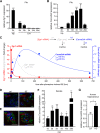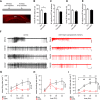Calcium Channel Subunit α2δ4 Is Regulated by Early Growth Response 1 and Facilitates Epileptogenesis
- PMID: 30792272
- PMCID: PMC6788814
- DOI: 10.1523/JNEUROSCI.1731-18.2019
Calcium Channel Subunit α2δ4 Is Regulated by Early Growth Response 1 and Facilitates Epileptogenesis
Abstract
Transient brain insults, including status epilepticus (SE), can trigger a period of epileptogenesis during which functional and structural reorganization of neuronal networks occurs resulting in the onset of focal epileptic seizures. In recent years, mechanisms that regulate the dynamic transcription of individual genes during epileptogenesis and thereby contribute to the development of a hyperexcitable neuronal network have been elucidated. Our own results have shown early growth response 1 (Egr1) to transiently increase expression of the T-type voltage-dependent Ca2+ channel (VDCC) subunit CaV3.2, a key proepileptogenic protein. However, epileptogenesis involves complex and dynamic transcriptomic alterations; and so far, our understanding of the transcriptional control mechanism of gene regulatory networks that act in the same processes is limited. Here, we have analyzed whether Egr1 acts as a key transcriptional regulator for genes contributing to the development of hyperexcitability during epileptogenesis. We found Egr1 to drive the expression of the VDCC subunit α2δ4, which was augmented early and persistently after pilocarpine-induced SE. Furthermore, we show that increasing levels of α2δ4 in the CA1 region of the hippocampus elevate seizure susceptibility of mice by slightly decreasing local network activity. Interestingly, we also detected increased expression levels of Egr1 and α2δ4 in human hippocampal biopsies obtained from epilepsy surgery. In conclusion, Egr1 controls the abundance of the VDCC subunits CaV3.2 and α2δ4, which act synergistically in epileptogenesis, and thereby contributes to a seizure-induced "transcriptional Ca2+ channelopathy."SIGNIFICANCE STATEMENT The onset of focal recurrent seizures often occurs after an epileptogenic process induced by transient insults to the brain. Recently, transcriptional control mechanisms for individual genes involved in converting neurons hyperexcitable have been identified, including early growth response 1 (Egr1), which activates transcription of the T-type Ca2+ channel subunit CaV3.2. Here, we find Egr1 to regulate also the expression of the voltage-dependent Ca2+ channel subunit α2δ4, which was augmented after pilocarpine- and kainic acid-induced status epilepticus. In addition, we observed that α2δ4 affected spontaneous network activity and the susceptibility for seizure induction. Furthermore, we detected corresponding dynamics in human biopsies from epilepsy patients. In conclusion, Egr1 orchestrates a seizure-induced "transcriptional Ca2+ channelopathy" consisting of CaV3.2 and α2δ4, which act synergistically in epileptogenesis.
Keywords: CaV3.2; Cacna2d4; early growth response 1; epileptogenesis; pilocarpine and kainic acid-induced status epilepticus; transcriptional Ca2+ channelopathy.
Copyright © 2019 the authors.
Figures




Similar articles
-
Long-term alteration of calcium homeostatic mechanisms in the pilocarpine model of temporal lobe epilepsy.Brain Res. 2001 Jun 8;903(1-2):1-12. doi: 10.1016/s0006-8993(01)02127-8. Brain Res. 2001. PMID: 11382382
-
Molecular imaging reveals epileptogenic Ca2+-channel promoter activation in hippocampi of living mice.Brain Struct Funct. 2015 Sep;220(5):3067-73. doi: 10.1007/s00429-014-0801-1. Epub 2014 Jun 3. Brain Struct Funct. 2015. PMID: 24889163
-
Commonalities and differences in extracellular levels of hippocampal acetylcholine and amino acid neurotransmitters during status epilepticus and subsequent epileptogenesis in two rat models of temporal lobe epilepsy.Brain Res. 2019 Jun 1;1712:109-123. doi: 10.1016/j.brainres.2019.01.034. Epub 2019 Jan 28. Brain Res. 2019. PMID: 30703372
-
Review: Animal models of acquired epilepsy: insights into mechanisms of human epileptogenesis.Neuropathol Appl Neurobiol. 2018 Feb;44(1):112-129. doi: 10.1111/nan.12451. Neuropathol Appl Neurobiol. 2018. PMID: 29130506 Review.
-
Defining "epileptogenesis" and identifying "antiepileptogenic targets" in animal models of acquired temporal lobe epilepsy is not as simple as it might seem.Neuropharmacology. 2013 Jun;69:3-15. doi: 10.1016/j.neuropharm.2012.01.022. Epub 2012 Feb 4. Neuropharmacology. 2013. PMID: 22342985 Free PMC article. Review.
Cited by
-
Neuronal α2δ proteins and brain disorders.Pflugers Arch. 2020 Jul;472(7):845-863. doi: 10.1007/s00424-020-02420-2. Epub 2020 Jun 30. Pflugers Arch. 2020. PMID: 32607809 Free PMC article. Review.
-
A CRISPR-Cas9-engineered mouse model for GPI-anchor deficiency mirrors human phenotypes and exhibits hippocampal synaptic dysfunctions.Proc Natl Acad Sci U S A. 2021 Jan 12;118(2):e2014481118. doi: 10.1073/pnas.2014481118. Proc Natl Acad Sci U S A. 2021. PMID: 33402532 Free PMC article.
-
Presynaptic α2δ subunits are key organizers of glutamatergic synapses.Proc Natl Acad Sci U S A. 2021 Apr 6;118(14):e1920827118. doi: 10.1073/pnas.1920827118. Proc Natl Acad Sci U S A. 2021. PMID: 33782113 Free PMC article.
-
Metabolite regulation of the mitochondrial calcium uniporter channel.Cell Calcium. 2020 Dec;92:102288. doi: 10.1016/j.ceca.2020.102288. Epub 2020 Sep 11. Cell Calcium. 2020. PMID: 32956979 Free PMC article.
-
Sleep deprivation of rats increases postsurgical expression and activity of L-type calcium channel in the dorsal root ganglion and slows recovery from postsurgical pain.Acta Neuropathol Commun. 2019 Dec 23;7(1):217. doi: 10.1186/s40478-019-0868-2. Acta Neuropathol Commun. 2019. PMID: 31870460 Free PMC article.
References
-
- Barclay J, Balaguero N, Mione M, Ackerman SL, Letts VA, Brodbeck J, Canti C, Meir A, Page KM, Kusumi K, Perez-Reyes E, Lander ES, Frankel WN, Gardiner RM, Dolphin AC, Rees M (2001) Ducky mouse phenotype of epilepsy and ataxia is associated with mutations in the Cacna2d2 gene and decreased calcium channel current in cerebellar Purkinje cells. J Neurosci 21:6095–6104. 10.1523/JNEUROSCI.21-16-06095.2001 - DOI - PMC - PubMed
Publication types
MeSH terms
Substances
LinkOut - more resources
Full Text Sources
Medical
Research Materials
Miscellaneous
